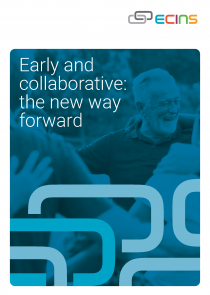The collaborative advantage
Safely sharing information to reduce risks, provide early support and save money.
When MOPAC (Mayor’s Office of Police and Crime) in London carried out a review of how they managed persistent violent offenders, they were looking for a new operational model to improve their data capture and consistency of reporting London-wide. Richard Norfolk, who was part of the team from the Mayor’s office, shares how a large part of their strategy involved encouraging wider use of ECINS.
Bringing risk matrices into alignment
‘E-CINS had already been adopted by MOPAC. It was being accessed by 32 London Boroughs as part of the Rescue and Response Project (which develops and delivers a support service for young people who are vulnerable and caught up in county lines drug distribution networks across the region).
‘Rather than have a risk matrix that is only police-orientated, [we want to] realise ECINS’ potential to revolutionise by combining all the current risk matrices into one, effectively bringing information in from all sources. This new combined risk matrix would include the Police IOM Risk Matrix, The Probation OGRS System and the Home Office Pathway Risk Matrix. This would enable us to come up with a combined risk score that takes into account all of the partner agencies’ scores.
‘Part of the IOM (Integrated Offender Management) review process will include a requirement for all London Boroughs to report detailed offender information through to MOPAC. The reporting requirements include how many offenders within specific periods, whether there has been a reduction in offending, criminogenic need and rehabilitation pathways accessed. ECINS offers many advantages in this area due to its ability to bring in data from multiple agencies.
Focusing on the whole picture
Another goal of this revised approach is to reduce reoffending by addressing people’s individual needs and taking a preventative rather than a reactive approach. Richard explains how this approach works.
‘If an offender has a drug habit, by working with them we aim to get their needs met to reduce their reoffending, reducing costs to society and the drain on the resources to the NHS, housing etc. We are aiming to reduce the cost of crime in London.
Collaborating to stop problems before they escalate
The potential of collaborative work practices to deliver more targeted and effective support are well documented. This style of working, however, does depend on operating within a fully secure system, which in the past has been difficult to find.
‘The biggest benefit ECINS brings is the ability to securely share information and the management of risk. If partners do not sign up and share information then they are leaving themselves vulnerable to organisational risk as the consequences of not sharing, acting or reacting to developing risk could be suicide or even homicide.
‘90% of our partnership are using ECINS to share information and those who don’t embrace it are leaving themselves vulnerable to risk and criticism for not sharing information in the most effective way.
Information sharing to identify those at risk
Another part of the MOPAC approach is to understand how one type of offence might be an early warning sign of a potentially worse offence down the track. The more these links can be understood, the more potential there is to provide support early.
‘It would be massively helpful if everyone in London was using E-CINS to share information. The Youth Offending Team in Barnet report that the majority of children in the area who are involved in County Lines (drug trafficking) are those who have been excluded from school. Many of these children have come into crime via burglary and robbery.
‘There are many crossovers between the various teams – ASB, Youth Offending etc and someone involved in County Lines might also appear on our IOM radar for robbery.
‘By using E-CINS we can map that activity and then track and monitor that individual. We have had cases in Barnet where individuals known to Barnet Youth Offending for burglary have been identified in another part of the UK and we’ve only been able to discover that through using ECINS.
‘ECINS enables us to identify who a person is and link in with the intelligence to see if there is anything we could be doing to mitigate the risk of harm to this person and the wider community’.


